
Bugsy and the Hundred Footer |
This is a true story of what not to do for the sake of DXing. False names have been used in order to protect the guilty. Seriously... this is a humorous story (sort of) but you should definitely not do this! This is not the correct method for erecting a fixed tower, and is dangerous.
Click any of the images to see a larger version
Bugsy was getting serious about low band DXing, 160 meters in particular. He had chased DX and done a bit of contesting on 160 some years earlier, but got distracted by VHF for a while. Now he was back, older, wiser (well, maybe not wiser, as we will see), starting to really understand the potential of this band. He had installed a rudimentary crop of Beverages the year before, to complement his inverted V which was now used just for transmitting. But he needed a serious vertical radiator. He also needed a permanent home for his newly built 6 meter yagi, which was now on a temporary 30 foot tower. His existing 80 foot tower was old and would need a lot of work to be used as a vertical. The guys would have to be redone, as they weren't broken up or insulated from the tower. That tower was originally installed for VHF antennas, but now held a 3 element HF tribander, his 160 meter inverted V, and some other wire antennas. The wire antennas would be another problem, as they would add too much top loading. They would have to be isolated from the tower. It was a very light duty tower and Bugsy didn't feel it could hold the 6 meter yagi in addition to the tribander. There was no question about it... he needed another tower!
Some investigation reavealed at least some of his old radial system, used 20 years earlier for an experimental 50 foot vertical, was still intact. The "clearing" where the old vertical had stood was a mess though, the forest having largely reclaimed it. With a little work, this would be a good spot for a tower. Bugsy had saved up enough money to buy a used tower, if he could find one. He sent an email to all the local hams he knew who had towers, thinking perahps, though it was probably a long shot, one of them might know of some tower sections for sale. It must have been his very, very lucky day, becasue he soon learned of two "complete" tower packages for sale in his area. He settled on a deal that included 130 feet of Rohn 25 tower, and more than enough guy wire (already suitably broken up with insulators) to do the job. Best of all, it fit his budget! The tower was in excellent condition. Bugsy would have loved to put up the whole 130 feet, but space constraints dictated it could be no more than 100 feet.
Now armed with tower and a plan, Bugsy wasted no time getting on the project. Summers were short in this neck of the woods, and he would have to move right along to complete the project before winter. The tower would be located at the center of the old radial system. Having surveyed where guy anchors would need to be placed, Bugsy got out the chain saw and cleared a small circle for the tower, plus three "swaths" for guy wires. For the most part, this was easy work, but there were a few "problem" trees. These trouble makers had high branches that needed to go, but they had no low branches for climbing! "Hmm," wondered puzzled Bugsy, "how'm I gonna git those down? Can't git theyah from heeah." He scratched his head. He paced back and forth. He sat on a stump to think, but that was interrupted by ants crawling up his leg. The longest ladder he had, a 20-footer, was not going to do it. He had 40 feet of old, badly banged up tower that would allow him access to the trees, if he could get it stood up alongside them. Suddenly the head scratching slowed, and became irregular. "Aha!" he exclaimed, running toward the shed.
Bugsy rounded up every pulley he could find, some long nylon ratchet straps, and other bits of hardware. He stood the 20-foot ladder against one of the tall trees, climbed to the very top and attached two pulleys to the tree using a strap around the trunk. He hastily assembled the old beat up tower sections, then attached two pulleys about half way along that assembly. Finding some old 2x6's, he fashioned a quick and dirty wood base for the tower. He strung rope thorugh all the pulleys, forming block and tackle to aid in pulling the tower up to a vertical position. He then drove two pieces of steel "U" channel into the ground at an angle between members of the wooden tower base, to prevent it from skidding as the tower went up. Bugsy grabbled the free end of the rope and pulled, but nothing happened. He wrapped the rope around one hand, grasped it tightly with the other hand, leaned back, and pulled harder. Nothing. The tower didn't budge. This thing was heavy! Finally he wraped the rope twice around his hips, then twisted the free end around the run going up to the first pulley on the tree. Grasping this twisted part of the rope as hard as he could, Bugsy leaned back, his body at something apporaching a 45 degree angle with the ground, dug in his heels, and gave a mighty pull. Bugsy groaned, and the tower lifted off the ground a full inch! This was going to work! His body now more horizontal than vertical, he dug one heel hard into the ground, then quickly moved the other foot back, hastily digging that heel in as well. Then the same for the other foot, and another big pull. The tower lifted two inches this time! Much heel digging, pulling, creaking and groaning ensued, but eventually the tower was upright alongside the tree. Who knew the thing could be so heavy? Bugsy muttered something under his breath, and quit for the day.
Next morning, his hips, back, and arms were sore but Bugsy was ready for action. he donned his old, stained climbing harness which he reserved for climbing trees only. Up the tower and into the tree he went, chain saw and telescoping pole pruner dangling from his harness. It was interesting climbing with that stuff. He got snarled up a time or two, but eventually reached the area of the offending branches, and proceeded to rid the tree of them. The process of erecting the old tower, climbing and removing branches continued for more than two weeks, until all the high obstructions were cleared.
Bugsy was happy to have the hard work out of the way, so he could get down to the fun, easy stuff. He set about digging holes for the tower base and guy anchors. Bugsy was a born hole digger. He started digging holes the day he was big enough to pick up a spade. Bugsy tried to drive the point of the spade into the ground at the first hole site, but it just bounced around. "Darn roots!", he exclaimed. "These trees just don't give up!" Out came the axe. After nearly a day of chopping and digging, the first hole was done. This irritated our DXer somewhat, as he fully expected to dig all four holes the same day. As it turns out, he did complete two the following day, but spent a day and a half on the last hole. It was more roots than dirt!
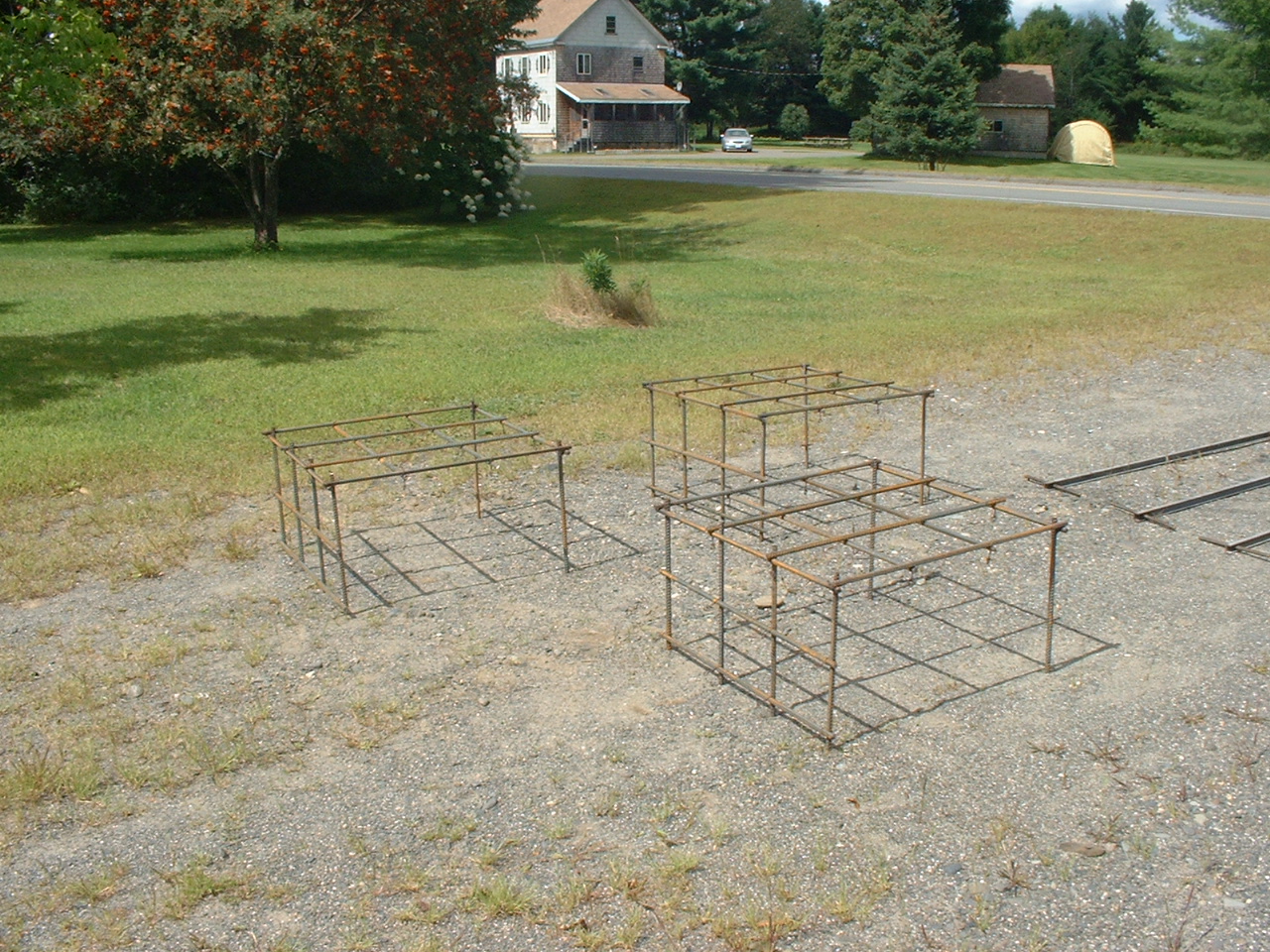 Bugsy fabricated rebar cages for the holes, and made his own guy anchors from some of that heavy steel "U" channel, thick metal plates, and grade 8 bolts. He wondered about the wisdom of this, but it fit his budget. He had been using similar anchors on the old tower, and so far no disasters had resulted.
Bugsy fabricated rebar cages for the holes, and made his own guy anchors from some of that heavy steel "U" channel, thick metal plates, and grade 8 bolts. He wondered about the wisdom of this, but it fit his budget. He had been using similar anchors on the old tower, and so far no disasters had resulted. 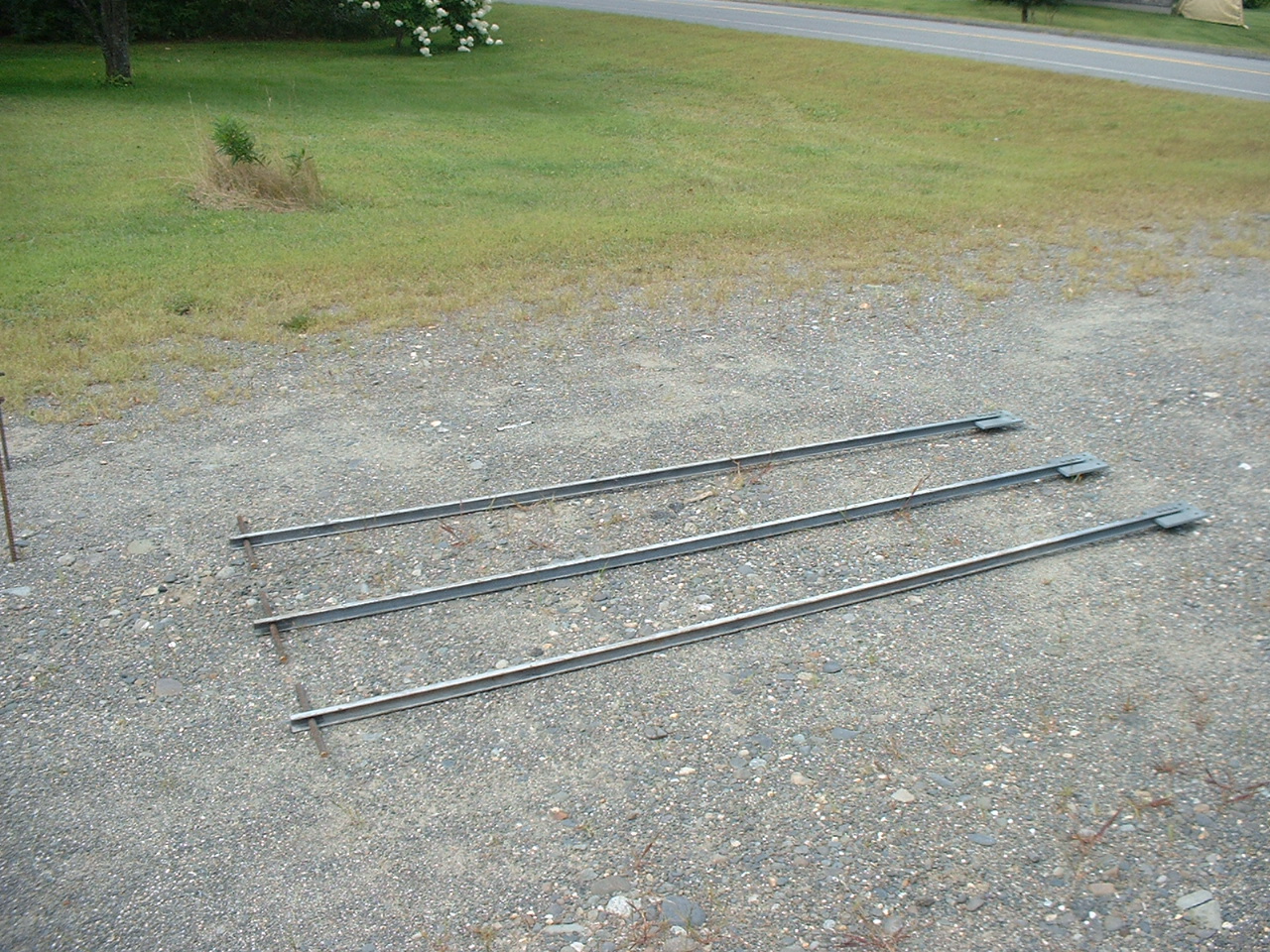 He had been slowly gathering coarse sand and crushed rock for the concrete, making one or two trips each day for the tiny amount he could haul home at one time. By now he had enough. Early one morning, out came the generator and cement mixer. It was a long day, but all the concrete was in by the time it got dark.
He had been slowly gathering coarse sand and crushed rock for the concrete, making one or two trips each day for the tiny amount he could haul home at one time. By now he had enough. Early one morning, out came the generator and cement mixer. It was a long day, but all the concrete was in by the time it got dark. 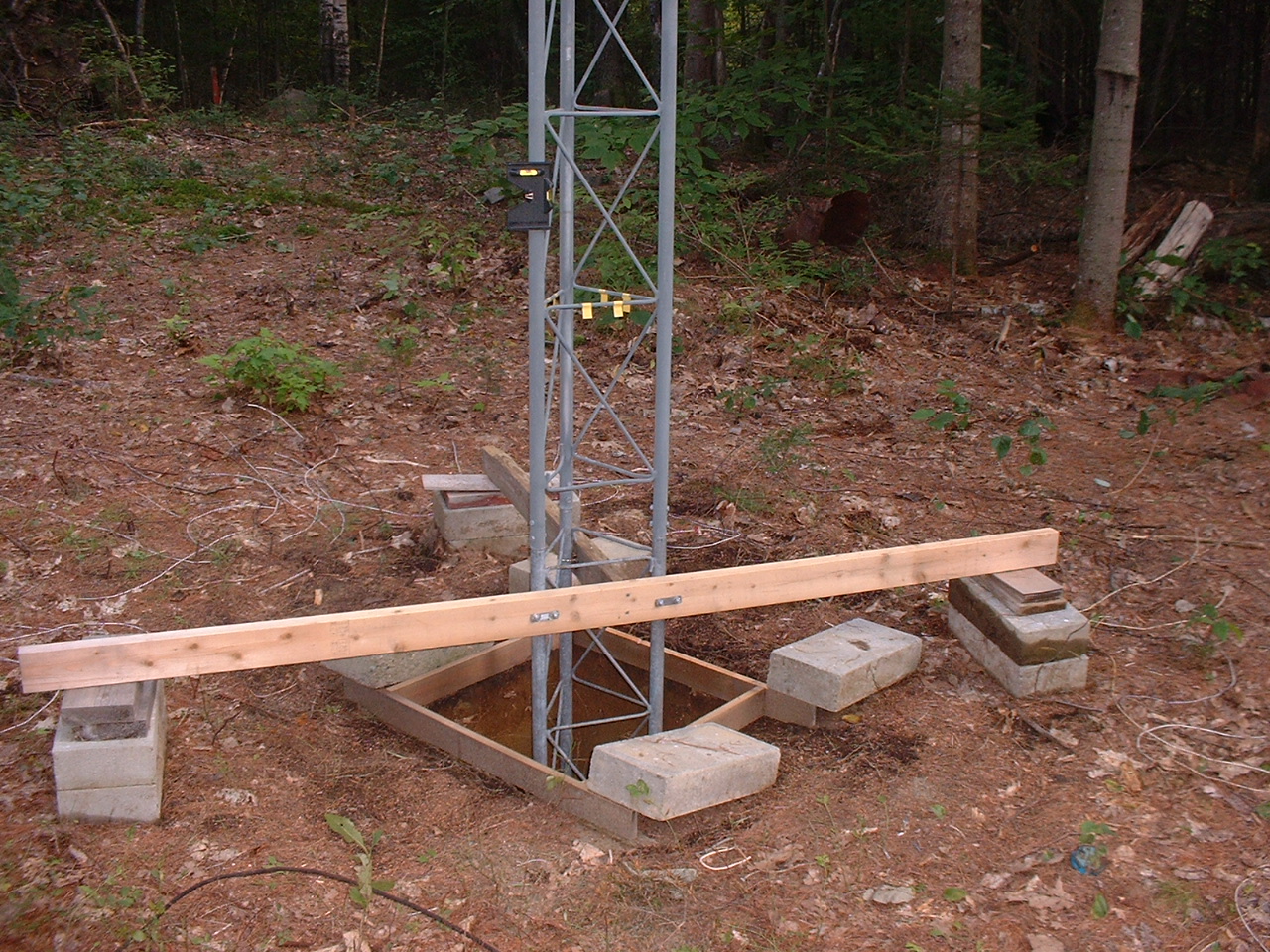 Perhaps it would be more accurate to say there was enough concrete in the ground to support the tower and anchors. Not all the concrete mixed that day went in the ground; our DXer was fairly well covered in it himself. If he'd stopped moving long enough, he might have hardened up and not been able to move! Large containers full of water were put by each hole, feeding a slow but steady amount of it to the curing concrete to aid in making it cure stronger. At least, that was the theory of it.
Perhaps it would be more accurate to say there was enough concrete in the ground to support the tower and anchors. Not all the concrete mixed that day went in the ground; our DXer was fairly well covered in it himself. If he'd stopped moving long enough, he might have hardened up and not been able to move! Large containers full of water were put by each hole, feeding a slow but steady amount of it to the curing concrete to aid in making it cure stronger. At least, that was the theory of it.
It was nice to have the grunt work behind him. Now Bugsy could get down to the enjoyable part of this project. While waiting for concrete to cure, he set about working on the radial system. A copper loop made of three eighth inch soft tubing was run around the top of the tower base, and electrically attached to the tower by three heavy wires. All the old radials were soldered to the loop, and Bugsy began running new radials. There were quite a few old, half rotted logs laying on the ground from trees long fallen, and each wire had to pass under any of these that were in its path. On a tip from a friend, Bugsy used a ground rod with a hole drilled trhough it at one end for the wire to pass through, as a "needle" to push the wire under these obstacles. Many of the wires he wanted to be invisible, so after they were run he carefully covered them with leaves gathered nearby. Crawling around the now ever-damp and cold forest ground in October wasn't too exciting. In fact, it was miserable work, hard on the knees and back.
He couldn't quite put his finger on it, but somehow Bugsy had an odd sense of deja vu as he thought "I'm glad the hard physical part of this is done, so I can start having fun with this." He set about erecting the tower. The concrete had been poured with about twelve feet of tower sticking out of the ground. Bugsy laid a tower secction on the ground, tied a rope to it, climbed to the top of the twelve-footer, and strapped on. He pulled up the next section using the rope, which he found to be a little hard on the arms, and proceeded to put it in place. Setting it in place with this "armstrong" method was a bit tricky though, and he wondered what would happen if he encountered a section that didn't fit easily. The thought even occurred to him this might be slightly dangerous. Pulling the sections up was going to be a lot more work as the tower got higher, too. For the next piece, he tried tying the tower section to his climbing belt and taking it up with him. That worked too, and was somewhat easier on his arms, but somehow setting it in place free hand still didn't seem quite right. There had to be a better way.
Bugsy had a gin pole which he was storing for a friend. He just couldn't figure out at first, how that would help him working alone. Then a real fine idea hit him! He knew how he was going to complete this project!  What troubled him was that he hadn't thought of this sooner. He would rig the gin pole as usual, but instead of having a helper on the ground pull the tower sections up, he would climb to the top with a weight and attach it to the rope where it exited the bottom of the gin pole. If the weight were just a couple pounds lighter than the tower section, it would make pulling the section up effortless. In his collection of amazingly good and useful stuff (which most people inexplicably referred to as junk), he found a type of clamp that would easily attach to the rope without damaging it, and would not slip.
What troubled him was that he hadn't thought of this sooner. He would rig the gin pole as usual, but instead of having a helper on the ground pull the tower sections up, he would climb to the top with a weight and attach it to the rope where it exited the bottom of the gin pole. If the weight were just a couple pounds lighter than the tower section, it would make pulling the section up effortless. In his collection of amazingly good and useful stuff (which most people inexplicably referred to as junk), he found a type of clamp that would easily attach to the rope without damaging it, and would not slip. 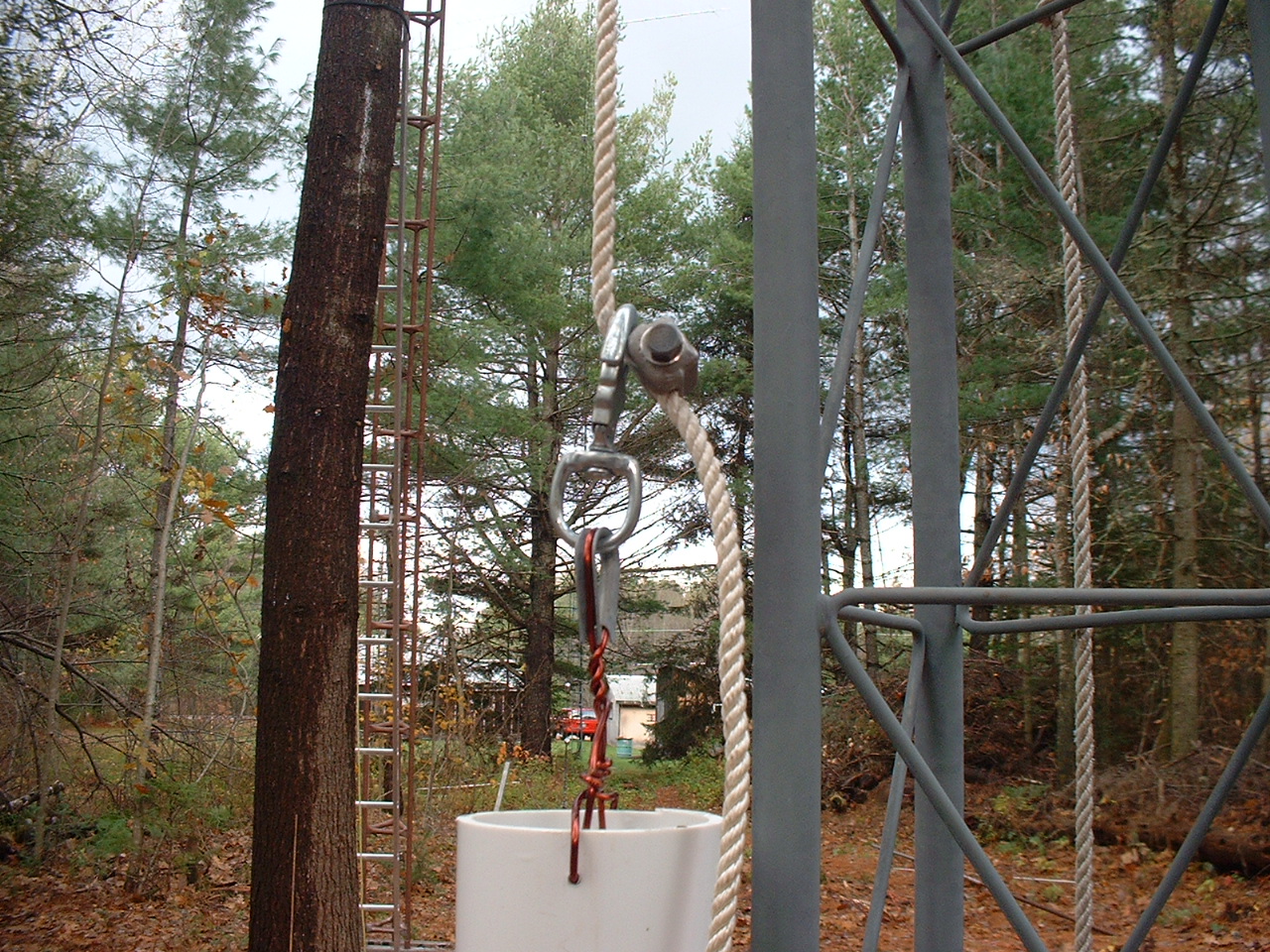 This would be used to help attach the weight. The weight iself, he made from a length of four inch schedule 40 PVC pipe, with rocks and a big chunk of steel square bar inside. Fortunately Bugsy saw the next problem coming before it "got" him. If he just rigged the gin pole and tower section to be erected as usual, then climbed up and attached the weight to the rope below the gin pole, the weight would reach the ground before the section got all the way to the top. That was undesirable, but easily solved. All he had to do, after rigging the section to go up, was pull it up a few feet while still on the ground, and tie off the rope. Then when he climbed to the top and attached the weight, the tower section would reach the top shortly before the weight reached ground level. He tried this new system on the next section and it worked great! He could bring the section up with just two fingers on the rope, and the weight counter-balancing it made setting the section in place much easier! It did require a lot of trips up and down the tower to rig things, since Bugsy was both tower and ground crew. But that was no problem. One by one the sections went up and the tower grew in height. Guys were attached and tensioned whenever a guy level was reached. Bugsy was aware temporary guys were recommended at the top of each new section during erection of a tower, but he didn't do that.
This would be used to help attach the weight. The weight iself, he made from a length of four inch schedule 40 PVC pipe, with rocks and a big chunk of steel square bar inside. Fortunately Bugsy saw the next problem coming before it "got" him. If he just rigged the gin pole and tower section to be erected as usual, then climbed up and attached the weight to the rope below the gin pole, the weight would reach the ground before the section got all the way to the top. That was undesirable, but easily solved. All he had to do, after rigging the section to go up, was pull it up a few feet while still on the ground, and tie off the rope. Then when he climbed to the top and attached the weight, the tower section would reach the top shortly before the weight reached ground level. He tried this new system on the next section and it worked great! He could bring the section up with just two fingers on the rope, and the weight counter-balancing it made setting the section in place much easier! It did require a lot of trips up and down the tower to rig things, since Bugsy was both tower and ground crew. But that was no problem. One by one the sections went up and the tower grew in height. Guys were attached and tensioned whenever a guy level was reached. Bugsy was aware temporary guys were recommended at the top of each new section during erection of a tower, but he didn't do that.
Of course, there was one section that didn't want to fit in place easily. Bugsy had pre-tested every section for fit while on the ground, except the last one. Every section had fit perfectly. Surely this last one would not be a problem. Oh, but it was! One leg was slightly out of alignment. It was the top section, and he only had one of those, so he had to make it fit! After fooling with it (at 90 feet in the air) for close to an hour, he realized this was no use. He tied the section off to keep it up there, and descended for more tools and supplies. Even though he knew what was holding the dangling top section up there, and trusted it, somehow climbing down (and up) the tower with that section moving to and fro in the breeze far above was, according to Bugsy, somehow slightly disconcerting. Several techniques were tried over the next two hours, but in the end a combination of a small turnbuckle between two legs of the section (to pull them closer together) and slight bending of a cross brace on the the section by whacking it repeatedly with a rubber mallet (interesting to do to a free-dangling tower section at 90 feet in the air) persuaded the thing to fit in place. The new tower was up!
Bugsy was happy to have the hard work out of the way, so he could get down to the fun, easy stuff. The rest of this project was going to be very easy. Up went the rotator and mast. Now it was time for the 6 meter yagi. He could hardly wait to see it proudly sitting in its new, permanent home atop this beautiful 100 foot tower! Having taken it from its temporary mounting place, Bugsy picked up the 30 foot long 6 meter antenna and proceeded toward the new tower site with it. Everything was going great, until he reached the edge of the woods and realized this antenna wouldn't go between the trees! No matter how he carried it or twisted and turned it, there was simply no way to get this antenna to that tower! This was just too ridiculous. Laughing, Bugsy set the antenna on the grass. He just stood there laughing. He laughed so hard and so long he felt like he might pass out. "Unbelievable", he thought, "I know I ain't zackly the brightest star'n the night sky, but how'n the heck I could overlook this problem I'll never know!" It took nearly a day to clear a path which the antenna could be (barely) manipulated through.
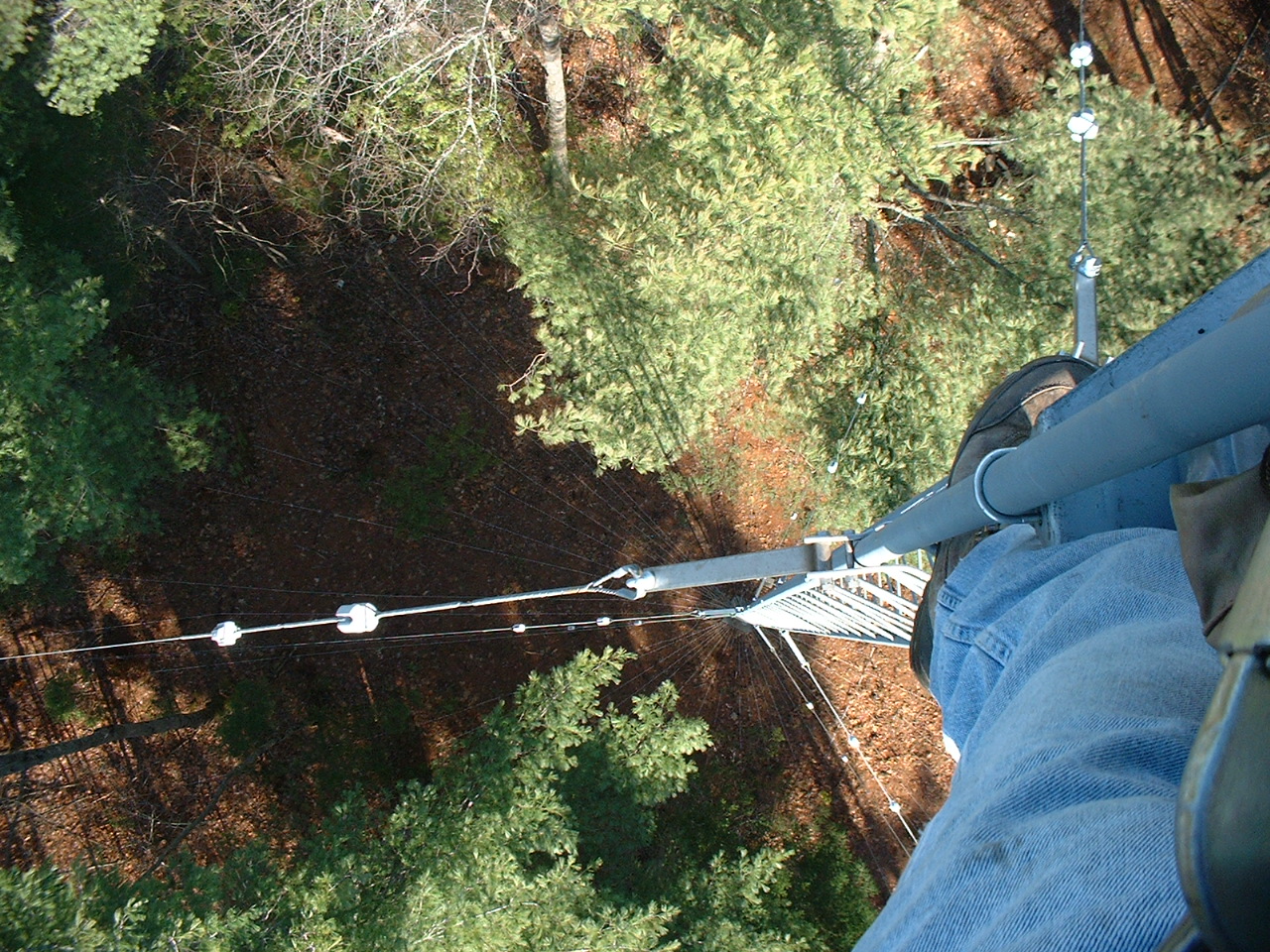
 The 6 meter yagi went up much the same as the tower sections, using the gin pole with a weight dangling on the rope.
The 6 meter yagi went up much the same as the tower sections, using the gin pole with a weight dangling on the rope. 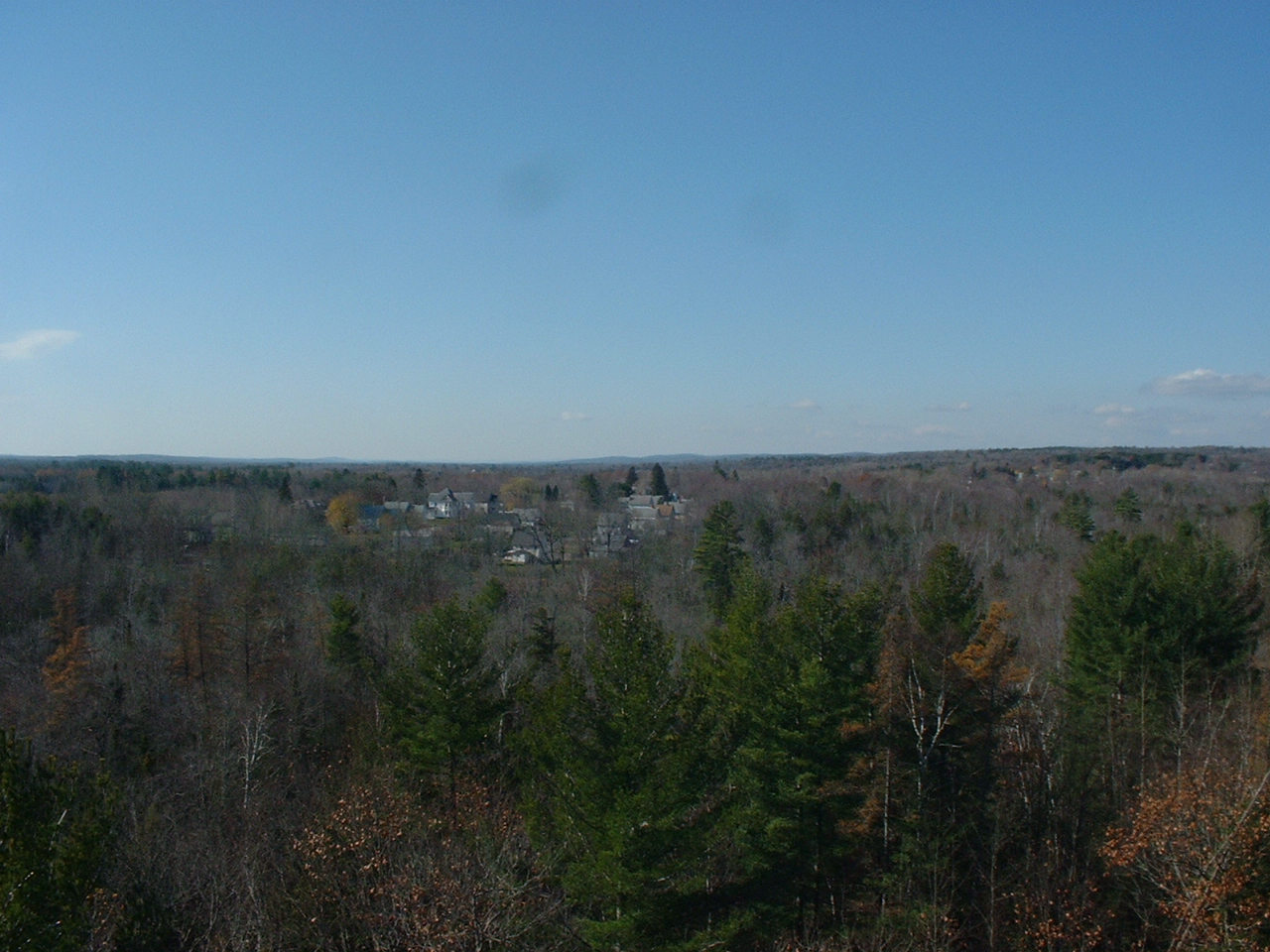 The exception was that this time Bugsy climbed the tower with the antenna, so as to manipulate it around tree branches that were close to the tower and guy wires. The antenna had to be flipped end for end at each guy level to get it around the wires. All went smootly and soon the antenna was up. A long run of 0.84 inch CATV hardline was run to and up the tower, along with rotor cable. The 6 meter antenna was now done! It looked and worked great now that it was up in the clear, above all obstructions.
The exception was that this time Bugsy climbed the tower with the antenna, so as to manipulate it around tree branches that were close to the tower and guy wires. The antenna had to be flipped end for end at each guy level to get it around the wires. All went smootly and soon the antenna was up. A long run of 0.84 inch CATV hardline was run to and up the tower, along with rotor cable. The 6 meter antenna was now done! It looked and worked great now that it was up in the clear, above all obstructions.
Bugsy had decided for the gamma match on the tower he would use some 6 AWG aluminum wire he had laying around, in a triangular cage approximately four inches on a side, stood off from the tower about three feet with fiberglass poles. He decided to make the gamma section go up 60 feet, because he wasn't sure where the tap would have to go and he didn't want to take any chances on it being too short. About the time he was starting to work on that, Bugsy became ill and had to put the project on hold. It was mid November now, and already getting cold working aloft.
There was a particular DX station in southeast Asia that Bugsy had heard twice and desperately wanted to work. He had not been able to make it with his inverted V, and was hopeful the vertical would help. Then one late November day, the vertical still not finished, Bugsy began hearing this station shortly before sunrise at the Asia end of the path. "Oh no!", Bugsy exclaimed, "This is torture! I get rare propagation on this one and the vertical ain't done!". What made it all the more amazing is the Beverage receive antennas were down due to storm damage, so he only had the noisy inverted V to listen on. Then something truly extraordinary happened. Bugsy was able to work this station using only his inverted V. Signals peaked to an astonishing 579. No one who knew him would ever say Bugsy was exactly "right" to begin with, but arguably he's been more borderline since that day. He is now a completely crazed DX hound and will take just about any foolish risk to improve or maintain his station!
Weeks passed, and finally one blustery January day Bugsy felt well enough to finish the vertical. He installed the gamma "cage" and set up the tuning box with a very large high voltage air variable capacitor at the base of the tower. He figured he would be making many trips part way up the tower to adjust the tap point, and it was not going to be fun. Reaching out more than three feet from the tower with both hands to attach clamps to all three wires of the gamma cage was scarcely possible. But, sooner or later something has to go smoothly. Astonishingly the first tap point tried resulted in a perfect match. His hands, ears and nose were numb from the cold. For a moment Bugsy wondered when the fun, easy part of this project was going to start. Slowly it dawned on him... there wasn't going to be an easy part! The long awaited vertical was finished! But in hindsight, it had all been fun, even if not exactly easy work.
Last update December 4, 2022